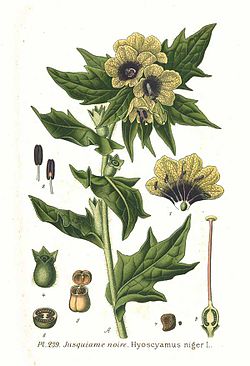Hyoscyamus niger (botany): Difference between revisions
>AndrewWiley I added the history of Shakespeare |
>AndrewWiley I added the history of Shakespeare |
(No difference)
| |
Revision as of 14:31, 23 September 2024

Hyoscyamus niger is known to cause dangerous and extremely unpleasant experiences.
Please use responsible use practices when trying this drug and always have a trip sitter.
| Hyoscyamus niger (botany) | |
|---|---|
 Drawing of H. niger |
|
| Taxonomical nomenclature | |
| Kingdom | Plantae |
| Unranked | Angiosperms |
| Unranked | Eudicots |
| Unranked | Asterids |
| Order | Solanales |
| Family | Solanaceae |
| Genus | Hyoscyamus |
| Species | H. niger |
| Common nomenclature | |
| Common names | Henbane, Stinking nightshade |
| Constituents | |
| Active constituents | Tropane alkaloids |
Hyoscyamus niger, commonly known as henbane, black henbane, or stinking nightshade, is a deliriant plant in the family Solanaceae.
Chemistry
The leaves and herbage contain S-(–)-hyoscyamine and S-(–)-scopolamine. Trace amounts of aposcopolamine, not scopolamine, littorine, tropine, cuscohygrine, tigloidine, and tigloyloxytropane have also been found.[1]
History
In the play Macbeth, by Shakespeare, when Banquo and Macbeth just had the encounter with the three witches, Banquo says in act 1 scene 3, (after encountering the witches and hearing their prophecies, Banquo wonders if they have been hallucinating. He says: "Were such things here as we do speak about? Or have we eaten on the insane root that takes the reason prisoner?" In this quote, the, "Insane Root" refers to Hyocyamus Niger, as Hyocyamus Niger was gaining popularity in Europe in the time of Shakespeare.
External links
References
- ↑ Rätsch, C. (2005). The encyclopedia of psychoactive plants: ethnopharmacology and its applications. Park Street Press. ISBN 9780892819782.